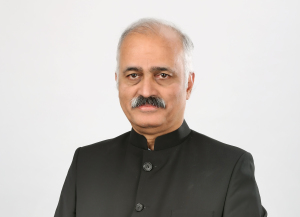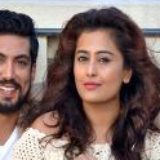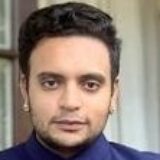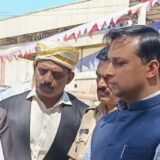Note: This article is an introduction to my proposed new book.
By P.T. Bopanna

Dr. Sarvepalli Radhakrishnan (1888-1975), former President of India, who was one of the most erudite Hindu scholars of all times, had said: “Hinduism is not a religion, but a commonwealth of religions. It is more a way of life than a form of thought. The theist and the atheist, the skeptic and the agnostic may all be Hindus if they accept the Hindu system of culture and life. Hinduism insists not on religious conformity but on a spiritual and ethical outlook of life. Hinduism is not a sect but a fellowship of all who accept the law of right and earnestly seek for the truth.”
The concept of Hinduism as propounded by Dr. Radhakrishnan was lofty and incorporated the essence of the ancient Indian civilization. But in the present era of ‘Mandal’ and ‘Kamandal’ politics, it is caste which determines the Hindu identity.
Kodavas are a unique race of people who live in Kodagu (Coorg, as the British called it), the smallest district in Karnataka. Very little is known about the origin of this community of warriors who have lived on the slopes of the Western Ghats of South India from time immemorial. This land-owning community known for its martial traditions, has a distinct culture that is strikingly different from that of the neighbouring cultures.
If caste is used as the yardstick to ascertain whether Kodavas are Hindus, then this small community numbering less than two lakh, are certainly not Hindus because they do not belong to any Hindu caste and there is no caste system among the Kodavas.
Another important factor which characterizes the Hindu caste system is the belief in the supremacy of Brahmanism. Judged from this yardstick too, Kodavas are not Hindus because there is hardly any role for Brahmins in the various Kodava ceremonies related to birth, marriage and death. It is the elders in the community who conduct all rituals.
Kodavas are basically ancestor and nature worshippers. Every Kodava is a member of a patrilineal okka (clan) that has descended from a common ancestor. The Karanava, the first ancestor of the clan, is revered as a God, and Kodavas worship the ancestral spirit, their Guru karona. While their ancestors are their guiding spirits, Kodavas consider their elders as their living guides. The youngsters greet their elders by touching their feet three times and the latter invoke their ancestors when they bless them.
Every ancestral home (ainmane) invariably has a kaimada, a small shrine nearby, where prayers to ancestors are offered. The ancestral homes face the East, and Kodavas start their daily chores by opening the main door of the house and saluting the sun in prayer. And idol worship is non-existent. A lamp (bolcha) or hanging lamp (thook bolcha) is lit, both at dawn and dusk, to invoke the blessings of the ancestors. The lamp is kept in the nellakki nadu bade (central hall in the ancestral home). The sacred area around the lamp is empty and no idol or photograph adorns the space. The same goes for the space where meedi (offerings to the ancestors) is kept. Most of the important decisions are solemnised in front of the lamp. However, in recent years in some ainmanes, framed photos of Hindu gods are kept in these sacred spaces. There are no idols in the kaimada, the central place of ancestor worship, where the annual ritual of Karonang kodpo is held in memory of the ancestors. A few kaimadas have figurines resembling humans, to represent their ancestors.
To sum up, Kodavas believe that there is a direct link between the living and their ancestors.
Kodavas worship river Kaveri as water and not as an image. During Kaveri Sankramana to celebrate the birth of the river, goddess Kaveri is symbolically represented by a decorated coconut or cucumber.
Another major deviation from mainstream Hinduism is the practice of meedi offerings for ancestors which consist of food items, including non-vegetarian dishes like pork, the signature dish of the Kodavas. Along with the food, liquor is also offered to invoke the blessings of ancestors. This practice is inconsistent with the rigid notions of ‘pollution’ practiced by orthodox Hindus.
Though Kodavas had maintained their own religious identity of ancestor and nature worship, things began to change after 1600 AD with the advent of the Lingayat or Haleri kings in Kodagu. The Haleri Rajas built Hindu temples and appointed deva thakkas (temple headmen) to propagate their faith among the Kodavas. Tulu and Kannada-speaking Brahmin priests were brought from outside Kodagu to perform pooja at these temples.
Over the years, temples dedicated to deities such as Bhagavati or Muthappan have come up in Kodagu. These deities were mainly imported from Kerala. Igguthappa, the god dedicated to rain and harvest, was also one such import from Kerala.
Kodavas also worship a few spirit deities like kulika, Pashana murthi, etc. who were imported from Tulunad or Kerala.
In today’s circumstances, it is essential to maintain the Kodava identity, instead of trying to embrace mainstream Hinduism. The belief in ancestor and nature worship is much more rational and scientific, compared to belief in myths and rituals which are alien to Kodava religious practices.

























Essential reading – https://swarajyamag.com/culture/am-i-a-hindu
This story I wrote for The Times of India long ago may be of interest.http://gauthammachaiah.blogspot.in/2008/05/hypothesis-is-that-they-could-be-kurds.html?m=1
Kodavas do not have a gothra like other Hindus. All other Hindus have gothras as they desend from a Muni. eg: Bharadwaj. We kodavas do not descend from any muni.
Not all Hindus have Gothras. Only the brahmins do.
An excellent Introduction and a good start. There is at present too much confusion and lack of consensus among Kodavas about our origin, history and religious beliefs due to over reliance on alien literature, which have resulted in our community and our homeland Kodagu not getting our due under the Constitution. Hope your Book will clear all the doubts and we would be in one grid. Wish you the best in your endeavour, which is much needed. Do try to translate it into Kodava Thak and publish as a serial in Kodava weeklies like Brahmagiri and Poomale for the benefit of those who cannot read English. Best of luck.
Great start by you to give a first hand information about Kodavas to the general public and also to the Kodavas.. Many of us don’t know our origin, our history, culture and the way our ancestors have maintained certain secrets which weren’t disclosed to outsiders.. Recently someone argued saying that the Kodavas are a race migrated from Persia and when asked him for the basis of his arguments he had no answers.. This will keep happening to all of us if we don’t know understand our history.. your book shall throw some light on our history.. Hope things will be better for us in the coming days.
A path-breaking study. Of course, there will be hoo haa’s. Please carry on. Also in my own opinion we have to see if any Hindu temples existed in Kodagu prior to the rule of Haleri kings.
We are a tribe and one of a kind. Our customs are unique like all other tribes in this country and we need to be classified under ethno-linguistic minority tribal to preserve our customs and to have a voice in the nation- building. The customs being distinctive to Coorgs alone and so are for every tribe in India who have unique customs in this country which are not entirely as described in the Vedas. During the freedom struggle, Lokamanya Tilak revived the celebration of Ganesha Chaturthi across the country to unify all the tribals on one common platform and create unity among diverse groups. Coorgs also got influenced by such spiritual practices. If such practices, be it Hinduism, Buddhism, Jainism, Christian, Islam or any such, brings in discipline and peace of mind for oneself and to the society, it is upto the individual to imbibe it. He/she does not have to give up his traditional customs to imbibe what he/she feels is good for oneself. Unlike Hinduism, other religions do not let you believe in any other philosophy than their own. You need to forego all other previous customs and traditions to be a part of that religion.
The practice of worshiping nature (Land, water, air, sky, fire) is the closest we have to Hinduism. That in itself is an evolution of modern Hinduism. And how far do we want to go with it, is an individual choice. Just the way I went to chapels and churches during my formative days. But that did not subjugate my core beliefs, customs and traditions passed down by my ancestors.
Tribes living over a vast expanse of land develop individual forms of worship out of their lives. It cannot be called religion. When those people start relating with another group of people over a long period of time, there is a dialogue between their belief systems. They grow by giving and taking. A common ground is discovered between the two. In other words, by conjoining the cores, a new one is created. When it merges with a third form of worship, a new common point is discovered.
well stated
Are Kodavas Hindus ? No…
Kodavas are converted Hindus..
It is too late to debate/discuss on this matter. I have been blogging on this subject since 8 years and found 95 % of them dont accept this fact. We cannot change the belief of those converted as this topic is very sensitive and may hurt the sentiments of some…
Excellent work. Preserving culture is possible only when the new generations know about the origin and practices followed by the ancestors.
First of all, we Kodavas must not be too lenient towards ‘pattamaas’. We should be wary of their ‘Koudi-manthra shasthras’.
Sir, this is a very important issue, which one must tread carefully. It may have become fashionable to disown Hinduism these days but beware of falling in this trap. Hinduism is not just about caste system and Brahminism, but it encompasses a lot more, some of which are even more remote and stranger than Kodava practises.
Kodavas are in this land for surely over 2500 years and have lived alongside Hindus without a doubt. They have retained Kodava practises without ever opposing the majority beliefs, rather both may have contributed to each other. Such existence is assimilation resulting in pluralism.
In all those years Kodavas have intermixed with surrounding people for endogamy is a practise of only the last 150 years. Strict endogamy results in diminishing populations like that of the Parsis who are practising endogamy only for 1200 years.
Genetically Kodavas are closer to the local Indians (read Hindu in this context). It is quite possible that Kodavas too are the children of the Indus Valley and the Vedic people. Are you ready to disown your heritage of the most advanced ancient forefathers? The contributors of numerals? the saints and philosophies? The ancient sciences and universities? The vast body of knowledge created by your ancestors? All because it is fashionable to denounce Hinduism?
DECCAN HERALD ARTICLE
The introduction to my proposed book ‘Are Kodavas (Coorgs) Hindus?’ was featured by Deccan Herald in their op-ed page on February 17, 2017.
Follow the link below to read the article:
http://www.deccanherald.com/content/596743/are-kodavas-belong-unique-race.html
This article beautifully debates the origin.It only asks us to be rational and give a moment’s thought of what may have been our ancestors’ beliefs. If not convinced, go back to the beliefs that you have found your peace in. The title maybe radical but the article isn’t. This is a great example of free speech with a dose of sensitivity.
I guess most of the non-Brahmin castes in Tulu and Malayali regions can be classified as ‘non-Hindus’, if we consider most of these points.
If we read M N Srinivas’s book on Kodavas, it’s very evident that the imported Brahmins to Kodagu did indeed have higher position in religious matters.
The Kodava paternal ancestry could be from different migrations but maternal ancestry is from local Malayali, Tulu and Kannada women. Only patriarchy can declare such a mix, ‘unique race’, and also doesn’t acknowledge its Dravidian maternal ancestry.
Kodavas are not Hindus because there is hardly any role for Brahmins in the various Kodava ceremonies related to birth, marriage and death.
So was the case with most of the castes in Tulu and Malayalam region. Only in the last 50 years, when purity-pollution rules have been made less stringent, Brahmins have started officiating the ceremonies. Otherwise, only ruling class(and not their entire caste) was part of the Brahmanical Hinduism.
Another major deviation from mainstream Hinduism is the practice of meedi offerings for ancestors which consist of food items, including non-vegetarian dishes like pork.
The author should have done some research on the other castes in the neighborhood. Meat and liquor to the ancestors is followed by the most of the non-Brahmin castes. Even for the spirits.
Kodavas are basically ancestor and nature worshipers. Every Kodava is a member of a patrilineal okka (clan) that has descended from a common ancestor. The Karanava, the first ancestor of the clan, is revered as a God, and Kodavas worship the ancestral spirit, their Guru karona.
The word ‘Karanava(n)’ is most likely from Malayalam. There Karanavan was the head of the matrilineal family. According the M N Srinivas, even Kodavas could have been matrilineal (and the rulers Jain, similar to Tulu and Malayalam regions) at an earlier time.
I wish to point out instances
where logical Kodava rituals have been
replaced by less scientific Hindu rituals:
1. Nellaki Nadu Bade, the sanctum sanctorum
of every Kodava Ainemane, until 19th century
had only two lamps (thook bolak and
mambolak). There were no idols or photos of
Hindu dieties. But, today you find a number of
photos of Hindu Gods ranging from
Dharmasthala to Shirdi Sai. Ancient Kodavas
used to offer meat and alcohol at this place for
the departed ancestors. At present due to the
presence of Hindu vegetarian God’s photos,
people have restricted themselves from
performing their rich tradition of offering
meat.
2. Naming ceremony of new-born child: In
ancient Kodag the mother would be in rest for
40 days after childbirth and she was not
expected to engage in any work, in order to
recover her strength and to devote herself
entirely to her child.
On the ceremonial day, she used to break her
rest by drawing water from the well. The
grandma used to select the name for the baby
which was not identical to any person in the
clan. But, these days, people go to Hindu
Purohit who suggests a starting letter of the
name in line with Hindu astrology. Hence, you
might have come across more than one
Bopanna and Somanna in the same clan.
3. Engagement or Mangala kuripuh was held at
bride’s house. A lamp was
lit, when the two Aruvas (neighboring clan) of
the respective families announced the
engagement in the presence of the sacred lamp
of Nellakki. Such engagements were rarely
broken.
Nowadays, Kodava families meet a Hindu
astrologer who sees whether the
stars of the couple will match or not, which I
believe is illogical. In several instances, the
alliance was called off even though the boy and
girl liked one another.
4. House warming ceremony: This ceremony
involves the owner of the newly built house to
shoot in the air from a gun and then enter the
house along with dhudikott paat (song that
praises owner’s efforts over hardship in
building the house). The owner will be in bolth
kupya (white traditional attire). Meat and
drinks will be served inside the new house.
Of late, the ceremony is so ridiculous that the
owner wearing white panche
(traditional lungi) sits beside the Purohit, who
performs the ‘homa’. The owner of the house
is barred from serving meat in the house for
three days.
5. New Year celebration: Kodavas’ New Year
starts from mid-April. Admyar is the first
month in Kodava calendar. On the auspicious
day of Admyar 1, cattle are bathed, a part of
paddy field is ploughed indicating start of
paddy
cultivation. Youngsters seek blessings from
elders.
Nowadays, most of the Kodavas are not
familiar with Admyar 1st. Many instead
celebrate Kannadigas’ Chandramana Ugadi as
New Year.
Why Kodavas celebrate Ugadi and not Edmyaar Ond?
Edmyaar Ond (the first day of the Kodava month of Edmyaar), is the New Year for the Kodavas. This year, the day falls on April 14. It marks the commencement of the Kodava calendar and the agricultural cycle in Kodagu. On this day prayers are said and cattle are yoked and made to plough the paddy fields.
Bisu Changrandi, the Kodava New Year’s day, corresponding to Vishu in Kerala and Vaisakhi in North India, is observed in mid-April. Also called Edmyaar Ond, Bisu commences when the sun seems to enter the first Zodiac sign of Aries.
Kodavas follow the solar calendar, which was the same as the Tulu, the Malayalam and the Tamil calendars, although the month names differed. While Kodagu and Dakshina Kannada followed the solar calendar, the rest of Karnataka followed the lunar calendar. The months of this lunar calendar begin and end with a new moon.
There is a reason as to why Kodavas now celebrate Ugadi and not Edmyaar Ond. The Rajas of Kodagu (c.1600 – 1834) came from the Shimoga region to Haleri in Kodagu. They followed the Hindu lunar calendar and implemented it in Kodagu for all administrative purposes during their reign. Their chief festivals were Ugadi, Shivarathri and Ayuda Pooja (Dasara). Thus these Hindu festivals were popularised in Kodagu.
Ugadi, when Bevu-Bella (neem leaves and jaggery) is eaten and mango leaves are hung upon doors, also happened to be a major festival in neighbouring Mysore. The event is showcased well by the present-day Kannada media. The influence of the neighbours and of the media has increased the popularity of the festival. As Kodavas moved out of Kodagu to live in the cities, Edmyaar Ond, observed in the fields, is no longer celebrated by them. The disappearance of paddy fields and oxen has led to the further neglect of the festival by Kodavas. Therefore, the significance of Edmyaar Ond faded while Ugadi gained prominence. Presently Kodava political outfits have been trying to popularise Edmyaar Ond in Kodagu once again.
The months of the Kodava calendar and their corresponding Indian zodiac signs are : Edmyaar (ram), Kadyaar (bull), Adare (twins), Kakkada (crab), Chingyaar (lion), Kanyaar (maiden), Tholyaar (scales), Birchyaar (scorpion), Dalmyaar (archer), Malyaar (crocodile), Kumbyaar (water bearer) and Minyaar (fish).
Good article about our culture… I am happy to bump into this article. It is an eye opener.
Informative.is the book available in stores
My sincere appreciation to the writer who has helped Kodava community to open their eyes to truth. If Kodavas have to prove they are a tribe, they have to come out of the mindset of being Hindus.
Are Kodavas Hindus, Yes they are. Do Hindus need to follow everything that Brahmins have written down? No!.
Like many other sects in India, like the lingayats, who too do not have gotra nor do they follow Brahminical way of worship, but still consider themselves as Hindus.
I Honestly think Kodava way of nature worship is supreme.
Question on if Kodavas are not indian origin, only a DNA analysis will answer that.